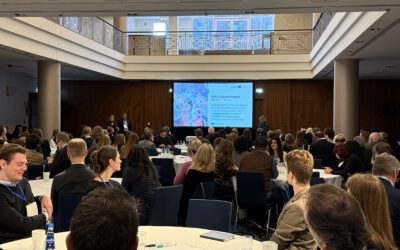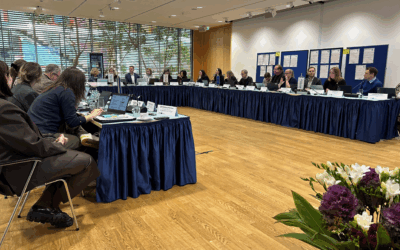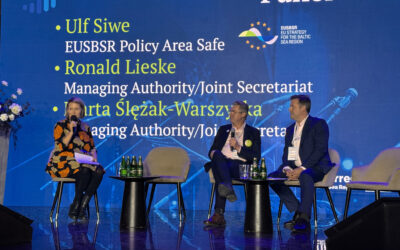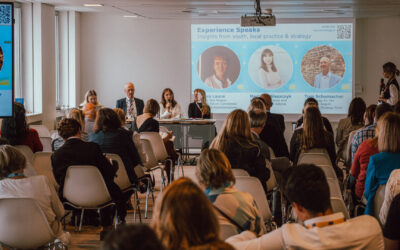People in the countryside release too many nutrients to the environment through their waste water because it is often not purified effectively. This problem was overlooked for many years. The Interreg project Village waters set out to make proper cleaning of waste water common practice across the rural areas around the Baltic Sea. In this interview, the project managers explain why they started the project and what they achieved.

Village Waters pilot site in Lithuania | Interreg Baltic Sea Region, © Villagewaters project
Jari Heiskanen
Jari Heiskanen, is a chemical engineer with nine years of work experience in waste water treatment businesses, who nowadays trains professionals in waste water management as well as in project management at SYKLI Environmental School of Finland in Helsinki.
Frans Silvenius
Frans Silvenius has been working with the treatment and environmental impacts of waste water as well as life cycle assessments for some 20 years and is a researcher at Natural Resources Institute Finland LUKE.
Virpi Vorne
Virpi Vorne is an organic chemist at the Natural Resources Institute Finland LUKE in Oulou with 25 years of work experience in food security and the state of the Baltic Sea. She coordinated the Interreg project Village Waters.
Why are village waste waters a problem?
Virpi Vorne: Well, the Baltic Sea Environmental Protection Commission HELCOM recently acknowledged that the amounts of nutrients, namely nitrogen and phosphorous, that come from scattered dwellings had been underestimated. Large municipal waste water treatment plants have been upgraded over the past 20-30 years and do not emit such large amounts of nutrients any more today. But villages and isolated houses still do.
Frans Silvenius: In Eastern European countries, waste water treatment equipment is often in place in the countryside, but it is not effective enough. The technology can be from the 1980s or even earlier and might not remove nutrients efficiently anymore. In addition, there are still areas with no wastewater treatment at all.
Why did you initiate this project?
Virpi Vorne: Many municipalities in Lithuania, Latvia, Estonia and Poland are aware of their problem with waste water treatment. The partners we have in the project wanted to become active to improve their local environments. And at LUKE we had the capacities to help them do it.
Frans Silvenius: For example, the administration of Šilutė District Municipality in Lithuania had a problem in the village of Leitgiriai, a village of about 100 inhabitants near the Curonian Lagoon. There had been a chicken farm in Leitgiriai, and the old waste water treatment plant was way too large and used by far too much energy. The new one that they installed within the Village Waters project uses several times less energy than the old one and cleans the water properly. And the solution has started to spread: several villages in the area are now getting ready to use the same technology for their village waste water cleaning. When we started, we had a number of municipalities with a very practical problem like this.
Which solution did you develop to improve water treatment in villages?
Virpi Vorne: We developed an online information tool that covers all commercially available small-scale waste water treatment systems in the region, from package plants to holding and septic tanks to infiltration beds and soil filters. We collected the data for altogether more than 650 products from 42 manufacturers based in six different countries. This data base provides first of all new information about many of the systems, and secondly it makes the different waste water treatment systems directly comparable. This is exactly what you need to decide for or against a certain system.
Frans Silvenius: For each treatment system, we analysed the entire life cycle – that means we started from the construction materials and the production of chemicals, we looked at the transportation and set-up as well as the regular operation and maintenance and dismantling of such a system. We assessed systematically the emissions of nitrogen and phosphorous as well as greenhouse gases. We pinned down the electricity consumption and the costs for each system at every stage.
Jari Heiskanen: It was a lot of work and not easy to get all the necessary data from the manufacturers. But once we had compiled all the data, we used them to create the online tool. We also compiled instructions and made a video on how to use the tool.
How does the Wastewater Solutions Information Tool work?
Jari Heiskanen: When you go to the info tool online, you can choose the country, the number of people that the system has to be able to cover, the space you have available to install such a system and finally a cost range that is affordable for you. And then you get a list of options to choose from. For each system you get a large amount of information, e.g. how large is the construction, how much do you need to invest, how often do you need to remove the sludge, and of course, what are the concentrations of nitrogen and phosphorous after treatment and how much greenhouse gases are emitted.
Who can use this new information?
Frans Silvenius: You can get information on the costs in relation to how much nitrogen, phosphorous and organic carbon is removed. This makes it interesting to the end users, such as municipalities and private people. It is also important to the manufacturers, because they see clearly how good their technologies are and at which stages of the life cycle they need to focus to improve their systems.
Why did you need a transnational project to do this?
Jari Heiskanen: We wanted to set up a tool that works and that people can actually use. With the help of our partners we could collect direct feedback from the users in a very interactive manner. In each country, i.e. Finland, Estonia, Latvia, Lithuania and Poland there was one research organisation and one to two municipalities. Together with them, we held workshops in nine municipalities to find out which information they actually look for. We also invited manufacturers and municipal advisors for waste water in several countries who consult citizens to give us feedback on their information needs. Without this input from several countries, the tool would have remained a theoretical exercise.
Frans Silvenius: The people working in the Village Waters project were very motivated to invest into this project and developed great solutions for different conditions together. Such solutions would not have happened if the partners had tackled their problems alone For example, in southern Poland at the edge of the catchment area of the Baltic Sea, in the municipality of Krynica-Zdrój Poland, we came up together with the idea for a special system for mountainous areas. The sewage slowly leaks down a slope and is cleaned by plants, grass and soil until it flows into a pond. This construction is very people- friendly abd therefore proper for agro touristic households. It needed quite some thinking, and in the end, the solution was so good that they established an educational path along it for visitors.
Virpi Vorne: And we learned a lot from each other. For example, to always be aware that the local situations differ very much. Now we have established a strong network that we can build up on to further work on small scale waste water treatment.
Interview by Stefanie Maack (Interreg Baltic Sea Region Managing Authority/Joint Secretariat).






